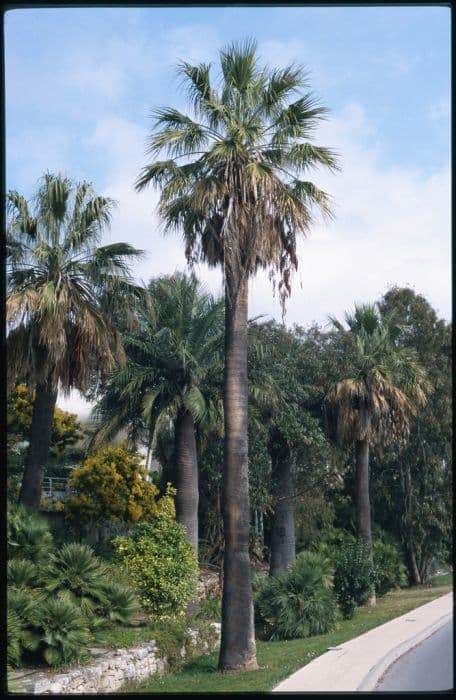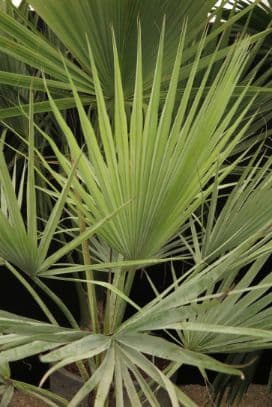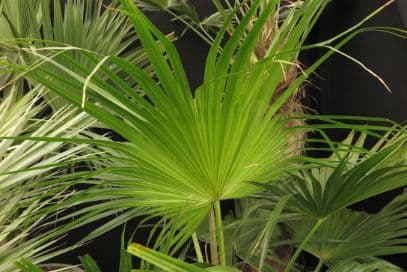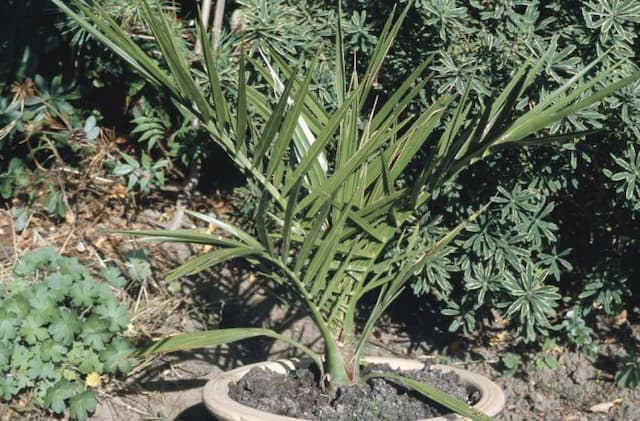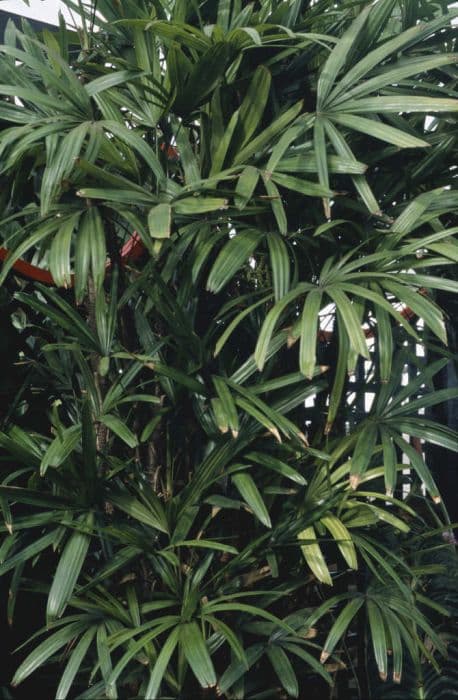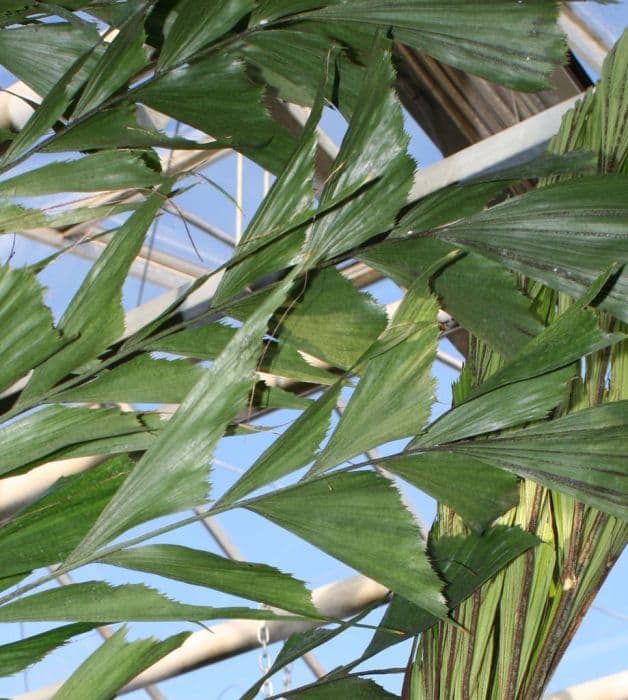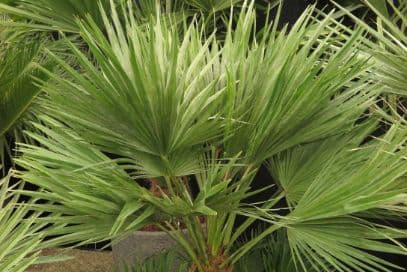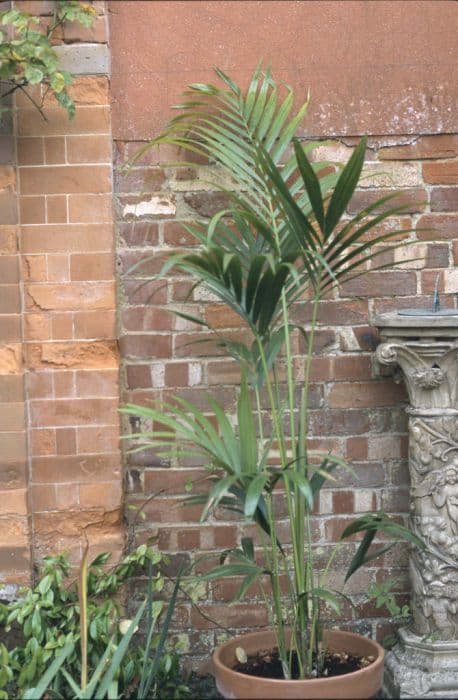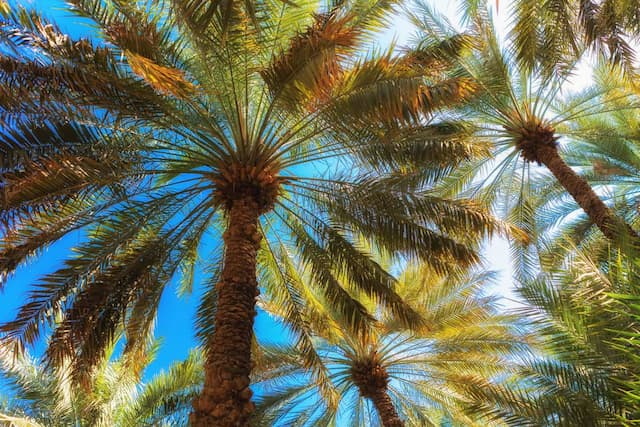Chinese Fan Palm Livistona chinensis

ABOUT
The Chinese fan palm is recognizable by its large, fan-shaped, glossy leaves that droop downward creating a fountain-like effect. Each leaf is divided into segments, almost like spokes of a wheel, and has a pleated appearance, which gives the leaves a textured look. The leaves emerge from a single, sturdy trunk which is crowned with the impressive foliage display. Moreover, the Chinese fan palm exhibits a lush green color that can add a tropical feel to any landscape. The leaf stems are also quite prominent and are armed with small teeth at the base, which are particularly noticeable when handling the plant. The overall shape of the plant is rounded, spreading outwards with its leaves. During its blooming period, the Chinese fan palm produces small, inconspicuous flowers that are followed by small, spherical fruits that may turn blue to black upon ripening. The plant's fruit is quite modest and often hidden within the dense foliage. The appearance of the Chinese fan palm with its wide-spreading leaves makes it a popular choice for gardeners looking to add an exotic touch to their gardens or indoor spaces.
About this plant
 Names
NamesFamily
Arecaceae
Synonyms
Chinese Fan Palm, Fountain Palm
Common names
Latania chinensis, Livistona oliviformis, Livistona subglobosa, Saribus chinensis, Livistona cochinchinensis, Livistona bonii, Livistona mindorensis, Livistona speciosa, Livistona woodfordii.
 Toxicity
ToxicityTo humans
The Chinese fan palm is not considered toxic to humans. There are no significant symptoms of poisoning associated with the ingestion of any part of the Chinese fan palm for humans.
To pets
The Chinese fan palm is not known to be toxic to pets. Ingesting parts of the Chinese fan palm should not cause any significant symptoms of poisoning in animals. However, as with any non-food plant, ingestion of large amounts could potentially cause mild gastrointestinal upset due to the fibrous nature of the plant material.
 Characteristics
CharacteristicsLife cycle
Perennials
Foliage type
Evergreen
Color of leaves
Green
Flower color
Yellow
Height
10 to 15 feet (3 to 4.5 meters)
Spread
6 to 10 feet (1.8 to 3 meters)
Plant type
Palm
Hardiness zones
9
Native area
China
Benefits
 General Benefits
General Benefits- Aesthetic Appeal: Adds a tropical look to landscapes with its large, fan-shaped fronds.
- Shade Provider: Creates a natural canopy that offers shade in gardens and parks.
- Habitat for Wildlife: Provides shelter and nesting sites for birds and other small animals.
- Erosion Control: The extensive root system helps stabilize soil and prevents erosion.
- Drought Tolerance: Once established, it is relatively tolerant to drought, making it suitable for xeriscaping.
- Low Maintenance: Requires minimal care once established, making it an easy plant for novice gardeners.
- Wind Resistance: Has a sturdy trunk and strong fronds that can withstand windy conditions.
- Cooling Effect: Transpires water through its leaves, which can help cool the surrounding area.
 Medical Properties
Medical PropertiesThis plant is not used for medical purposes.
 Air-purifying Qualities
Air-purifying QualitiesThis plant is not specifically known for air purifying qualities.
 Other Uses
Other Uses- The large leaves of the Chinese fan palm have traditionally been used as umbrellas and for thatching roofs.
- Fibers derived from the leaves can be used to make brooms and brushes.
- In some cultures, the palm is incorporated into religious and ceremonial objects or as part of festival decorations.
- The seeds of the Chinese fan palm have been used in landscaping as a natural means to add a decorative touch to garden beds.
- The sturdy, fan-shaped leaves are often used in crafting, especially in the creation of fans, hats, and mats.
- Young shoots and hearts of palm are edible and considered a delicacy in some culinary traditions.
- The wood from the trunk is occasionally used in making small furniture or decorative items due to its texture and appearance.
- The fronds may be employed as a natural fencing material or screen for privacy in tropical and subtropical landscaping.
- Chinese fan palm leaves are sometimes used as canvases for painting, where artists may depict traditional or tropical scenes.
- Innovative uses include the transformation of dried leaves into organic compost or mulch for gardening purposes.
Interesting Facts
 Feng Shui
Feng ShuiThe Chinese Fan Palm is not used in Feng Shui practice.
 Zodiac Sign Compitability
Zodiac Sign CompitabilityThe Chinese Fan Palm is not used in astrology practice.
 Plant Symbolism
Plant Symbolism- Resilience and Strength: The Chinese Fan Palm, Livistona chinensis, is known for its hardy nature and ability to withstand various growing conditions which symbolizes resilience and the capacity to cope with hardships.
- Elegance and Grace: With its graceful, fan-shaped leaves, it represents beauty, poise, and refinement in the plant kingdom.
- Persistence and Longevity: As the Chinese Fan Palm can live for many years, it is often associated with longevity and the persistence of life.
- Prosperity and Wealth: In some cultures, palms in general are seen as symbols of prosperity and good fortune, and thus the Chinese Fan Palm might also be associated with these traits.
- Tropical Relaxation: Because it is commonly found in tropical environments, the Chinese Fan Palm can evoke feelings of relaxation and leisure, often being symbolic of a laid-back lifestyle and holidays.
 Water
WaterThe Chinese Fan Palm prefers to be watered thoroughly, allowing the soil to dry out slightly between watering sessions. During active growth in spring and summer, water the plant roughly every 7 to 10 days with about 16 to 32 ounces of water, depending on pot size and indoor conditions. In fall and winter, reduce watering frequency to every 2 to 3 weeks, ensuring to avoid waterlogging as this can cause root rot. It's crucial to provide adequate drainage to prevent excess water from accumulating at the bottom of the pot.
 Light
LightThe Chinese Fan Palm thrives in bright, indirect sunlight and can tolerate some direct sunlight. However, too much direct sun can scorch the leaves, so a spot near a window with filtered light or a little distance from a south-facing window is ideal. Avoid placing it in low light conditions, as this can lead to poor growth and weak fronds.
 Temperature
TemperatureThe Chinese Fan Palm does well in average room temperatures between 65 and 80 degrees Fahrenheit. It can survive temporarily in temperatures as low as 50 degrees Fahrenheit, but for optimal growth, maintaining the temperature within the preferred range is advisable. This palm should be protected from cold drafts and sudden temperature fluctuations.
 Pruning
PruningPruning the Chinese Fan Palm is mainly for aesthetic purposes—removing dead or yellowing fronds to maintain its attractive appearance. Light pruning can be done at any time of the year, but major pruning should be conducted in spring or early summer when the plant is actively growing. Prune sparingly, as excessive cutting can stress the plant.
 Cleaning
CleaningAs needed
 Soil
SoilChinese Fan Palm prefers a well-draining soil mix with some organic matter. A mix of two parts peat, one part pine bark, and one part coarse sand or perlite is ideal. Maintain a soil pH between 6.0 and 7.0 for optimal growth.
 Repotting
RepottingChinese Fan Palm should be repotted every 2 to 3 years to avoid becoming root-bound. Younger plants may require more frequent repotting, while mature palms grow slower and can be repotted less often.
 Humidity & Misting
Humidity & MistingChinese Fan Palm thrives in moderate to high humidity levels. Aim for a relative humidity around 50-60% for optimal growth conditions.
 Suitable locations
Suitable locationsIndoor
Place in bright, indirect light and away from drafts.
Outdoor
Choose a sheltered spot with partial shade and well-draining soil.
Hardiness zone
USDA zones 9-11.
 Life cycle
Life cycleThe lifecycle of the Chinese Fan Palm (Livistona chinensis) begins with seed germination, where the seeds sprout in warm, moist soil after a dormancy period. Following germination, the seedlings establish a root system and grow their first set of true leaves, entering the juvenile phase where the palm slowly develops its characteristic fan-shaped foliage. As it matures, the Chinese Fan Palm experiences a phase of rapid growth where it develops a thick, solitary trunk and an expanded canopy of leaves. The adult palm then reaches reproductive maturity, typically after several years, producing inflorescences that emerge below the crown shaft, bearing small flowers that are pollinated by insects. After pollination, the flowers develop into blue-black, berry-like fruits, each containing a single seed that can be dispersed by animals or gravity. The life cycle completes when these seeds create new plants, continuing the cycle.
 Propogation
PropogationPropogation time
Spring to summer
The Chinese fan palm, scientifically known as Livistona chinensis, is most commonly propagated through seeds. The best time for sowing seeds is during the warm season when temperatures are between 70 and 100 degrees Fahrenheit (21 to 38 degrees Celsius), as warmth is critical for germination. Seeds should first be soaked in warm water for 24 to 48 hours to soften the outer shell and encourage germination. After soaking, the seeds are sown in a well-draining soil mix, lightly covered with soil, and kept consistently moist. It is important to provide a humid environment, which can be accomplished by covering the pot with plastic. Seed germination can be slow and may take several months, and patience is key in this process. Once the seedlings have emerged and grown large enough to handle, they can be transplanted into individual pots to continue growing until they are ready to be planted in their permanent locations.
